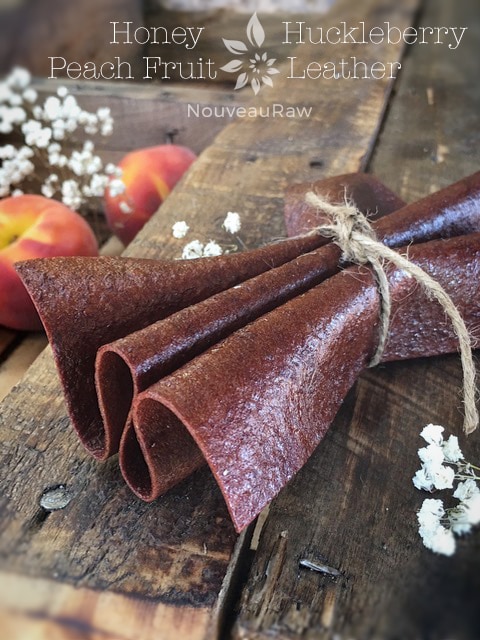Honey Huckleberry Peach Fruit Leather

 Add to favorites
Add to favorites

~ raw, vegan, gluten-free, nut-free ~
I love surprises and life is full of them! I am new to eating huckleberries, so I really didn’t have a preconceived idea as to what to expect but after pulling this fruit leather out from the dehydrator, I was shocked to find that it tasted just like concord grapes!
It reminded me of Smuckers Grape Jelly. Speaking of Smuckers, a few years ago Bob and I got a personal tour of one of their plants in Washington. My aunt, Kathy, has worked there for around 20 years. It was rather impressive, and that is coming from a girl who doesn’t eat store-bought jams.
My aunt and uncle also have a 28-acre vineyard of a variety of grapes. One of which is Concords. And since the huckleberries in the fruit leather reminded me of grape jelly, which led to reminiscing about visiting Smuckers, which then made me think of concord grapes. Don’t you just love how my brain bounces all over the place? Haha, At least there is a little method to my madness.
Back to the leather…. focus must stay focused! The flavor was strong and oooh so delicious! Grape jelly-like Smuckers like concord grape-like… Huckleberry like?
Along with being so tickled in being able to find fresh, wild huckleberries, I also had the pleasure of getting my hands on some locally made honey that was flavored with huckleberries. I realize that not everyone will have access to such a thing. In that case, you can use regular honey or whatever sweetener you desire. Ok, before I lose my train of thought again, let me just introduce you to the recipe and let you be. :)
Ingredients:
yields 3 cups puree
- 2 cups fresh huckleberries
- 2 cups chopped peaches
- 1 Tbsp huckleberry honey
- 1 tsp vanilla extract
Preparation:
- Select RIPE or overly ripe fruit that has reached a peak in color, texture, and flavor.
- Puree the fruit, honey, and vanilla, in the blender or food processor until smooth.
- Taste and sweeten more if needed. Keep in mind that flavors will intensify as they dehydrate.
- When adding a sweetener do so a little at a time, and reblend, tasting until it is at the desired taste.
- It is best to use a liquid type sweetener. Don’t use granulated sugar because it tends to change the texture.
- Spread the fruit puree on teflex sheets that come with your dehydrator. Pour the puree to create an even depth of 1/8 to 1/4 inch. If you don’t have teflex sheets for the trays, you can line your trays with plastic wrap or parchment paper. Do not use wax paper or aluminum foil.
- Lightly coat the food dehydrator plastic sheets or wrap with a cooking spray, I use coconut oil that comes in a spray.
- When spreading the puree on the liner, allow about an inch of space between the mixture and the outside edge. The fruit leather mixture will spread out as it dries, so it needs a little room to allow for this expansion.
- Be sure to spread the puree evenly on your drying tray. When spreading the puree mixture, try tilting and shaking the tray to help it distribute more evenly. Also, it is a good idea to rotate your trays throughout the drying period. This will help assure that the leathers dry evenly.
- Dehydrate the fruit leather at 145 degrees (F) for 1 hour, reduce temp to 115 degrees (F) and continue drying for about 16 (+/-) hours. The finished consistency should be pliable and easy to roll.
- Check for dark spots on top of the fruit leather. If dark spots can be seen it is a sign that the fruit leather is not completely dry.
- Press down on the fruit leather with a finger. If no indentation is visible or if it is no longer tacky to the touch, the fruit leather is dry and can be removed from the dehydrator.
- Peel the leather from the dehydrator trays or parchment paper. If it peels away easily and holds its shape after peeling, it is dry. If it is still sticking or loses its shape after peeling, it needs further drying.
- Under-dried fruit leather will not keep; it will mold. Over-dried fruit leather will become hard and crack, although it will still be edible and will keep for a long time
- Storage: To store the finished fruit leather…
- Allow the leather to cool before wrapping up to avoid moisture from forming, thus giving it a breeding ground for molds.
- Roll them up and wrap them tightly with plastic wrap. Click (here) to see photos of how I wrap them.
- Place in an air-tight container, and store in a dry, dark place. (Light will cause the fruit leather to discolor.)
- The fruit leather will keep at room temperature for one month, or in a freezer for up to one year.
Culinary Explanations:
- Why do I start the dehydrator at 145 degrees (F)? Click (here) to learn the reason behind this.
- When working with fresh ingredients, it is important to taste test as you build a recipe. Learn why (here).
- Don’t own a dehydrator? Learn how to use your oven (here). I do however truly believe that it is a worthwhile investment. Click (here) to learn what I use.
© AmieSue.com
Tags: Dairy Free, Gluten Free, Nut Free, Refined Sugar Free, Soy Free, sugar free, Vegan



 Add to favorites
Add to favorites